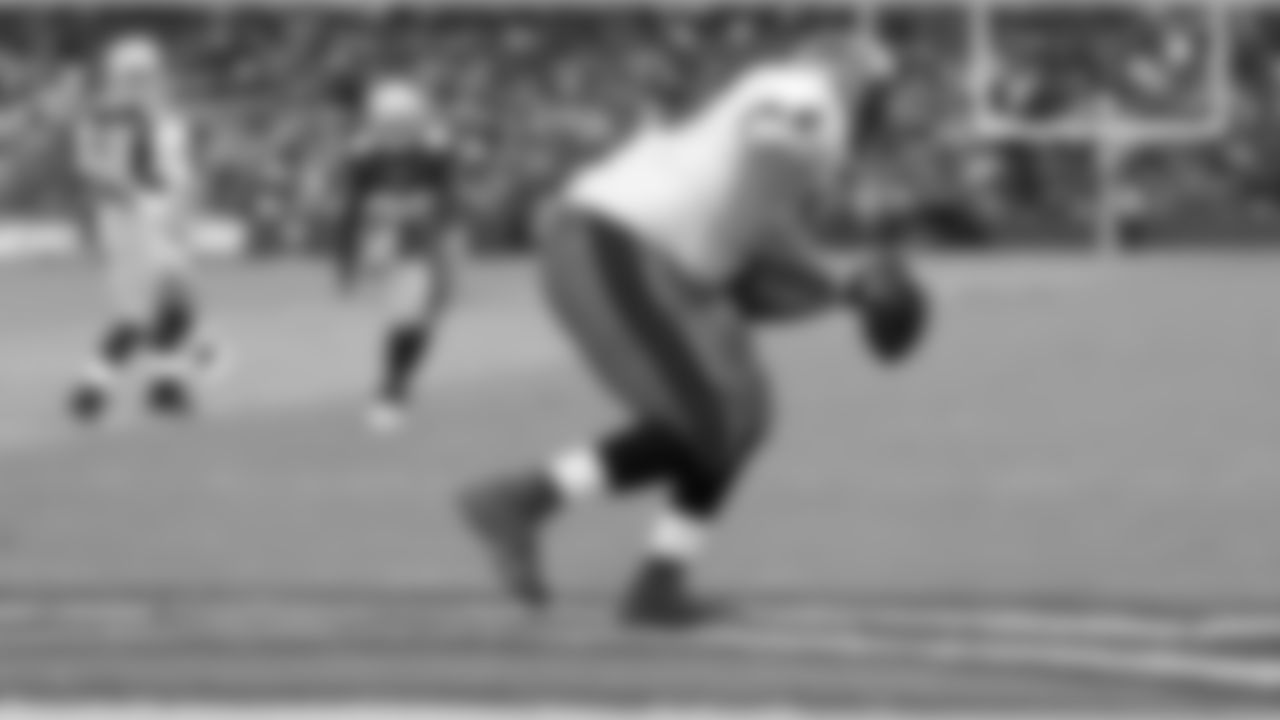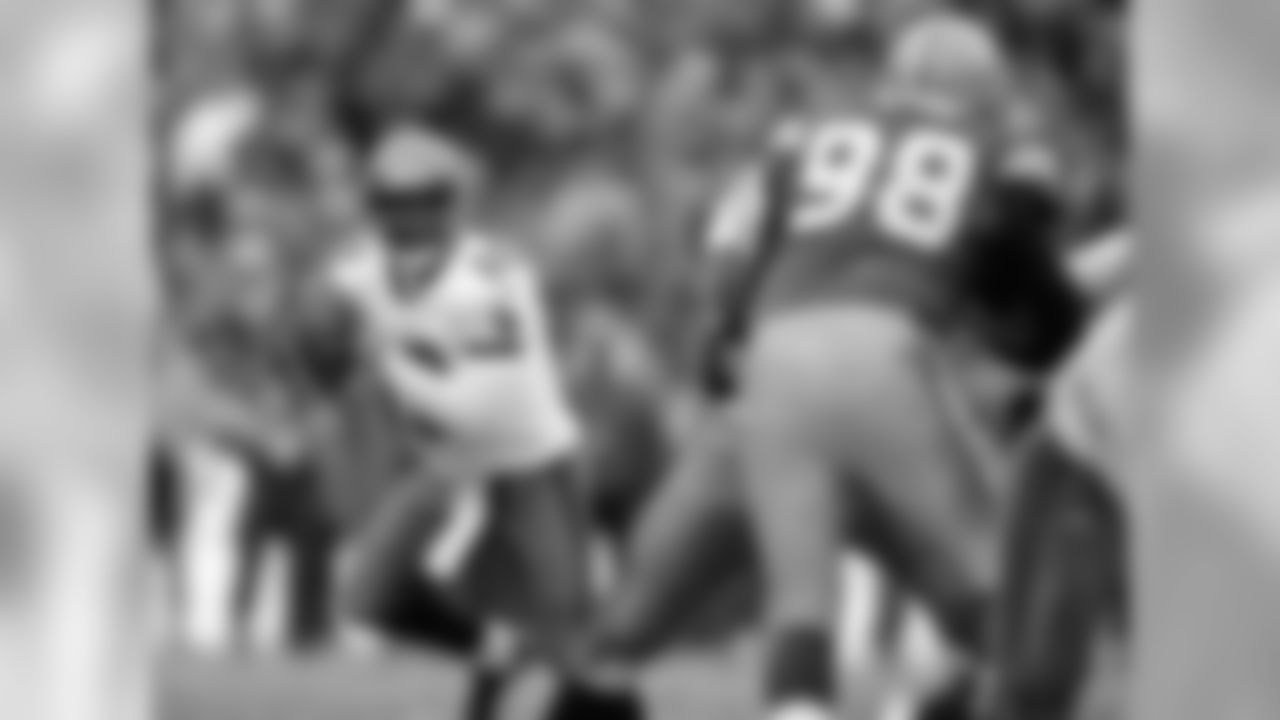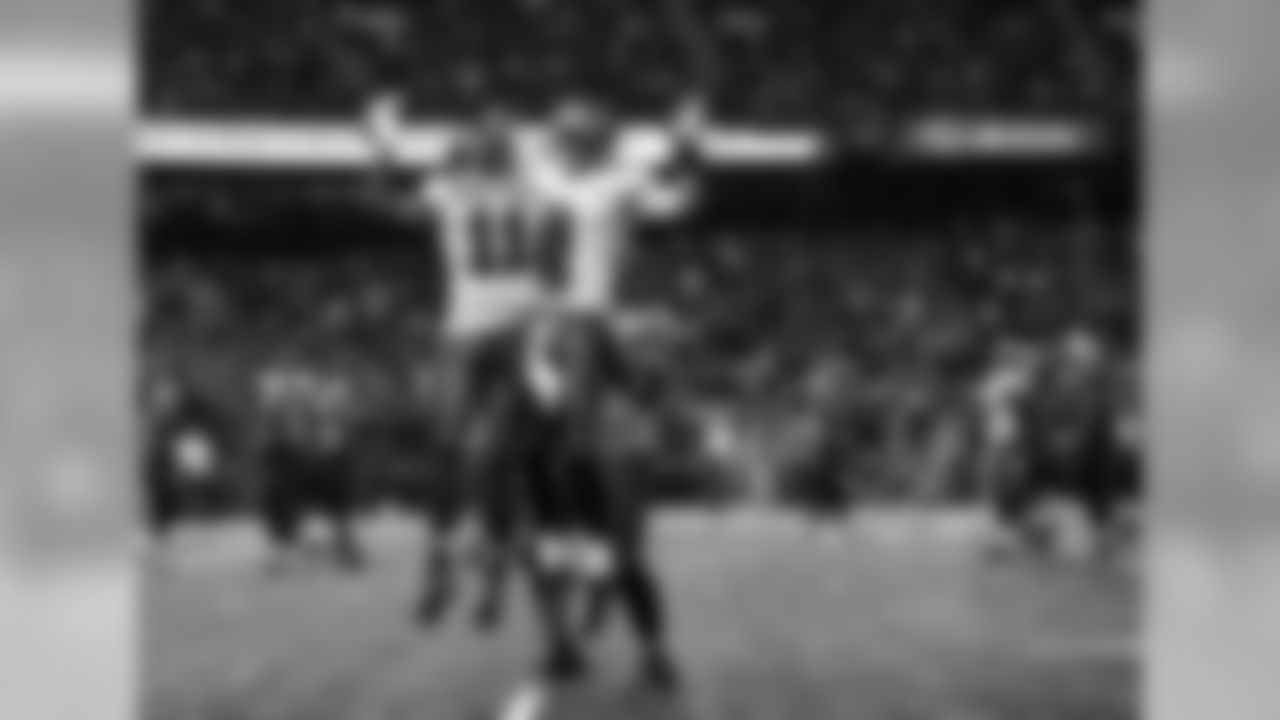
Donald Penn scores one for the big guys

Shaun King scores two on an option pitch.

Warren Sapp dusts off his TD dance.

"Insurance" Graham pulls off the halfback pass.

Bucs run the flea flicker to perfection.

Ron Hall feigns a fall.

John Lynch is off to the races after a fake punt

>PFWA: McCoy named All-NFC
> **PFWA: Evans named All-Rookie**
Bucs all-second day team
> NFC South: Links from Jan. 11
> 5 things to know: OC Koetter
> Bucs name Dirk Koetter OC
> Dungy, Lynch HOF finalists
> McDougald's 7 offseason plans
> TBT: '02-'03 divisional playoffs
> One Buc Mailbag
> 3 things to know**: N**ew Bucs
> Evans nominated for ROY
The NFL's Divisional Playoff Round is considered by many to be the best football weekend of the year, and this season's version didn't disappoint. New England, Seattle, Green Bay and Indianapolis (in that order) advanced to next week's Conference Championship Round, and in the aftermath of those 12 great hours of football we were left with three prevailing storylines.
With apologies to the somewhat predictable action in Seattle, those storylines are: Bill Belichick's offensive creativity, Dez Bryant's non-catch and Peyton Manning's health. Let's talk about the former.
Belichick's Patriots ran a series of plays on which only four offensive linemen were on the field and various skill-position players took turns being the fifth ineligible player. On every offensive snap in an NFL game, there are six players who are eligible to handle the ball and five who are not; 99% of the time, those five ineligible players are the offensive linemen. The NFL helps its referees keep track of this by requiring players at each position to wear numbers in a certain range. For example, all offensive linemen wear numbers between 50-79, so as soon as an official sees that, he knows the player is ineligible. If a player in that range is going to be eligible on a certain play, he must tell an official, who then announces it to everybody.
That's a relatively common occurrence, most notably when a team brings in a sixth offensive linemen to create a bigger offensive front in short-yardage plays. What is far less common, but really just the flip side of the same coin, is for a player with an eligible number (such as something in the 30s or 80s, like a running back or a tight end) makes a point of declaring himself ineligible. It is the rarity of this act, in fact, that the Patriots pointedly used to their advantage.
On the most memorable play in the sequence, TE Michael Hoomanawanui lined up on the left end of the offensive line, making it look as if he was the ineligible left tackle. In fact, he was eligible when the play began and never declared himself otherwise. Meanwhile, RB Shane Vereen lined up on the line but in the slot and told the official that he was ineligible. He was, essentially, the right tackle, but he looked like a slot receiver. Since he was ineligible to go downfield, he simply took a step back at the snap and acted like he was expecting a pass. Instead, Hoomanawanui released directly up the field from the line and since he was uncovered, Brady very quickly and easily hit him for a gain of about 10.
Baltimore Ravens Head Coach John Harbaugh was upset about this during and after the game, not because the Patriots' shuffling of their eligible and ineligible players was against the rules but because he felt his defense wasn't given any time to adjust after the changes were announced. That's a trickier subject, because the Patriots weren't substituting in order to change their eligibles; they were, in fact, just changing eligibles.
No matter how you feel about what the Patriots did, you have to admit they were creative. And that's what makes the occasional trick play so much fun: the creativity (not to mention the surprise factor). Dozens of times in each game we get to marvel over the incredible physical talents of NFL players; when a trick play pops up, we get to be impressed by a coach's brainpower and guts as much as anything.
So let's take a moment to celebrate the trick play. Below we've gathered seven of the more memorable trick plays during the last quarter-century of play for the Buccaneers. We'll do these in chronological order,
1. Ron Hall feigns a fall.

Sam Wyche's first Buccaneer team was off to a good start in 1992, with blowout wins over Phoenix and Green Bay and a close loss at Minnesota. In Week Four, they went to Detroit and got locked in a back-and-forth battle that included four lead changes in the second half. The last one swung it to the Bucs' favor, as Vinny Testaverde's 14-yard touchdown pass to Ron Hall gave the Bucs a 27-23 victory and a 3-1 start.*In some ways, this was a typical misdirection play, with a fake handoff and a delayed release by the tight end, Hall, on the backside of the play. There was a little extra subterfuge to it, however. The always-creative Wyche had coached Hall to appear to fall down on the play; Hall went down to a knee and, as hoped, the defense wrote him off. He then popped back up and sprinted into some wide-open field on the left side. Easy touchdown. 2. John Lynch is off to the races. *

The Buccaneers didn't win their game vs. Seattle in Week Four of the 1996 season, but they did pull off the most successful fake punt in franchise history. With the game tied at 3-3 in the second quarter, the Bucs sent Tommy Barnhardt out to punt on a fourth-and-two from their own 40. John Lynch, who played a lot on special teams before emerging as a star defender, was the "upback" or "personal protector" for the punter. Long-snapper Dave Moore shot the ball back to Lynch instead of Barnhardt, and the safety dashed through a huge hole to the right of the center and hit the open field.*Lynch would gain 40 yards on the play, setting up a Reggie Brooks touchdown run that put the Bucs up by seven. Lynch might have scored himself if he hadn't been tripped up by the punt returner at the Seattle 20. That punt returner? None other than future Buccaneer star Joey Galloway. 3. Shaun King scores two on an option pitch. *

On the final weekend of the 2000 regular season, the Buccaneers trailed 14-3 on a frigid late afternoon at Lambeau Field as the fourth quarter began. By that point, the visitors knew that a victory would secure them the NFC Central title and a first-round bye. Perhaps buoyed by that possibility, they put together a furious rally to tie it at 14-14 before the quarter was half over. The key series was a Shaun King-to-Keyshawn Johnson touchdown pass followed by a successful two-point conversion.*It was the two-point play that falls into our "trickeration" category. On the play, King lined up under the center took a snap and turned to hand off to RB Warrick Dunn, who headed towards left guard. Instead of trying to power through the line, however, Dunn handed off to FB Mike Alstott on a reverse, with Alstott cutting behind the line from left to right. After the handoff, King had peeled off to the right, so that when Alstott came around the corner he would have the option to run it in or pitch it back to the quarterback. With a defender in his way, Alstott pitched to King, who ran in untouched. The unfortunate epilogue: A 40-yard field goal try by Martin Gramatica at the end of regulation just missed after LB Jamie Duncan had intercepted Brett Favre near midfield. The game went to overtime, where the Packers prevailed, sending the Bucs into a doomed Wild Card matchup at Philadelphia. 4. Warren Sapp dusts off his TD dance. *

The 2003 Buccaneers were a talented and confident bunch coming off their Super Bowl XXXVII win at the end of the previous campaign, even more so after they opened the new season with a dominant road win at Philly. That '03 campaign would eventually come off the rails thanks in part to a rash of injuries, but in Week Three the Bucs were still feeling their oats.*That was especially true for Pro Bowl DT Warren Sapp, who had managed to work his way into the offense in some short-yardage packages. The big linemen was mostly used as a blocker from fullback or tight end slots, but given his famous athleticism, there wasn't much doubt he would eventually get the ball in his hands. In fact, he caught a 14-yard pass, the first of his career, in that win at Philly. It wasn't until Week Three, however, that Sapp found the end zone. On first-and-goal at the Atlanta six-yard line, the Bucs lined up with Sapp as a tight end on one side of the line and DT Anthony McFarland as a tight end on the other side. Sapp released off the line at the snap and ran into the end zone, where he was found by QB Brad Johnson for a short touchdown pass. To celebrate the occasion, Sapp unveiled his very memorable Beyonce hopping dance. 5. "Insurance" Graham pulls off the halfback pass. *

RB Earnest Graham was known for doing whatever the Buccaneers needed, from toiling on special teams to serving as a blocking back to handling the main load for the rushing attack. In Week Nine of the 2008 season, the Buccaneers needed a little something extra from Mr. "Insurance" Graham.*The 5-3 Bucs went to Kansas City to take on the 1-6 Chiefs but quickly found themselves in a 24-3 second-quarter hole. A Clifton Smith 97-yard kickoff return for a touchdown got the Bucs started but they were still down by 11 at the beginning of the fourth quarter. After back-to-back fumbles left the Bucs in a first-and-goal at the Chiefs' three, Jon Gruden called Graham's number, but not as a runner. Instead, Graham took a handoff from QB Jeff Garcia cutting from left to right, then pulled up and threw a perfect pass to TE Alex Smith in the end zone for a touchdown. Graham's pass kept the comeback going and Tampa Bay eventually won in overtime, 30-27. Graham would throw two passes in his NFL career, both of them for touchdowns. 6. Donald Penn scores one for the big guys. *

Warren Sapp is one of two non-offensive skill position players in franchise history who have scored more than one offensive touchdown. The other is former left tackle Donald Penn. Like Sapp, Penn had a sneaky amount of athleticism and fine-motor skills hiding in his in-the-trenches physique. For instance, he once won his team a day off from practice by successfully fielding a punt from the JUGS machine.*The Bucs used that athleticism to hit Penn on a total of three passes during his eight years with the team. Two of those went for touchdowns on the classic "Tackle Eligible" play, the first one occurring at San Francisco in Week 11 of the 2010 campaign. The Buccaneers dominated the game from start to finish, winning 21-0 and allowing just 189 yards of offense, and that gave them a chance to make their big lineman happy. On third-and-goal from the San Fran one, the Bucs showed a jumbo look, with both Penn and DT Roy Miller as eligible blockers. Penn slid over from his left tackle spot into the eligible role on the left end of the line and ran a shallow out at the snap. QB Josh Freeman faked a handoff, rolled left and easily hit Penn for the game's final touchdown. 7. Bucs run the flea flicker to perfection. *

The flea flicker is one of the NFL's classic trick plays and it is quite often successful when pulled out at the right time and executed properly. In this case, the Buccaneers got it just right. On first-and-10 from just across midfield, QB Mike Glennon handed off to RB Bobby Rainey, who started directly up the middle of the field. After taking a step or two, however, Rainey stopped and pitched the ball back to Glennon.*The Bucs got what they wanted from the ruse, with the Saints' safeties biting up the handoff to help in run support. WR Tiquan Underwood simply sprinted pass the defense and was well beyond the last Saint defender when Glennon threw up the perfect 48-yard arc into the end zone. *It may not have been the most significant flea flicker in NFL history – the Bucs would go on to lose, 42-17 – but it was carried out to utter perfection. In fact, NFL.com writer Alex Gelhar used Glennon's pass as his example when including the flea flicker in his list of the league's best trick plays last April.






















